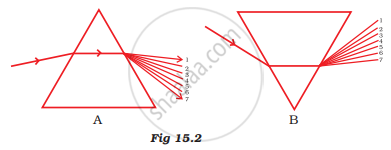Advertisements
Advertisements
Question
State the correct sequence (1-7) of colours in the spectrum formed by the prisms A and B, shown in Figure 15.2.

Solution
In figure A and figure B
| Figure A | Colour | Figure B |
| 1 | Red | 7 |
| 2 | Orange | 6 |
| 3 | Yellow | 5 |
| 4 | Green | 4 |
| 5 | Blue | 3 |
| 6 | Indigo | 2 |
| 7 | Violet | 1 |
APPEARS IN
RELATED QUESTIONS
Draw a ray diagram to explain the term angle of deviation.
(i) A ray of white light breaks up into its components while passing through a glass prism. Draw a ray diagram to show the path of rays.
(ii) Mark the least deviated colour in your diagram

(iii) Why do different coloured rays deviate differently in a prism?
As light rays pass from air into a glass prism, are they refracted towards or away from the normal?
What is spectrum? What is the name of glass shape used to produce a spectrum?
Which of the following colour of white light is least deviated by the prism?
(a) green
(b) violet
(c) indigo
(d) yellow
You are given a disc divided into seven sectors with colours violet, indigo, blue, green, yellow, orange and red in them. What would be its colour when it is rotated rapidly?
A ray of white light is passed through a glass prism and a spectrum is obtained on a screen.
- Name the seven colours of the spectrum in order.
- Do the colours have the same width in the spectrum?
- Which of the colour of the spectrum of white light deviates (i) the most, (ii) the least?
Answer the following question:
Differentiate between a glass slab and a glass prism. What happens when a narrow beam of
(i) a monochromatic light, and
(ii) white light passes through
(a) glass slab and
(b) glass prism?
Which of the following is a natural phenomenon which is caused by the dispersion of sunlight in the sky?
State True or False:
"Wavelength of red light is close to 700 nm.”
